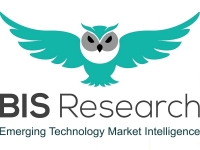Technology
GLOBAL INDOOR FARMING TECHNOLOGY MARKET To Reach $12.02 Billion By 2024
According NEW MARKET INTELLIGENCE REPORT

(Source: BIS Research)
USPA NEWS -
According to a New Market Intelligence Report by BIS Research titled 'Global Indoor Farming Technology Market - Analysis and Forecast, 2018-2024', the indoor farming technology market is expected to reach $12.02 billion by 2024, rising at a CAGR of 15.23% from 2019 to 2024. The growth of the market is largely attributed due to the Adoption of Technologies pertaining to Indoor Vertical Farms along with Software and Services in the Indoor Farming Industry.
According to a New Market Intelligence Report by BIS Research titled 'Global Indoor Farming Technology Market - Analysis and Forecast, 2018-2024', the indoor farming technology market is expected to reach $12.02 billion by 2024, rising at a CAGR of 15.23% from 2019 to 2024. The growth of the market is largely attributed due to the Adoption of Technologies pertaining to Indoor Vertical Farms along with Software and Services in the Indoor Farming Industry.
Making enough Food available for the population has become an alarming Issue for Governments while meeting the Never-Ending Demand for Food prevalent across the Globe. Based on the Global Report on Food Crises 2019 by Food and Agriculture Organization (FAO), the count of Chronically Hungry Population across the World was recorded at over 100 million since 2016. The most severely affected are the Low-Income Populations of Countries in South America and South Africa.
Making enough Food available for the population has become an alarming Issue for Governments while meeting the Never-Ending Demand for Food prevalent across the Globe. Based on the Global Report on Food Crises 2019 by Food and Agriculture Organization (FAO), the count of Chronically Hungry Population across the World was recorded at over 100 million since 2016. The most severely affected are the Low-Income Populations of Countries in South America and South Africa.
Identifying this Global Concern, Various Companies have currently come up with a Range of Technologies, which assist in cultivating Crops Indoors as a Substitute to Traditional Farming. These Technologies help in maximizing the Quality, Productivity, and Sustainability in Agricultural Production Systems.
The increasing Global Warming, rising Temperatures, and unexpected Weather Conditions are becoming Barriers to Optimum Agricultural Production Outdoors, while Studies have shown that adverse Global Warming in the coming years directly impacts the Global GDP, thus making Economies financially weak. Increasing Adoption of the Indoor Farming Concept across the Globe is driving the Demand for Advanced Technologies in Indoor Farming, since these are important for running an Indoor Farm. Optimum Lighting, Temperature, and Humidity are the Key Factors to operate an Indoor Farm Profitably.
The increasing Global Warming, rising Temperatures, and unexpected Weather Conditions are becoming Barriers to Optimum Agricultural Production Outdoors, while Studies have shown that adverse Global Warming in the coming years directly impacts the Global GDP, thus making Economies financially weak. Increasing Adoption of the Indoor Farming Concept across the Globe is driving the Demand for Advanced Technologies in Indoor Farming, since these are important for running an Indoor Farm. Optimum Lighting, Temperature, and Humidity are the Key Factors to operate an Indoor Farm Profitably.
Additionally, Technologies in an Indoor Farm are a Valuable Option because these provide Accurate Climatic Factors along with Specific Insights from Monitors to take better Farm Decisions. The Companies present in the Indoor Farming Technology Market have engaged in numerous Product Developments and launches to improve their market Presence. It is expected that by 2020, more Technologically advanced companies will enter the Indoor Farming Technology Industry and Resources will consolidate further.
According to Harveen Bawa, analyst at BIS Research, "In 2018, the indoor farming technologies market by type of technology is dominated by hardware systems. These systems have been predominantly used by indoor farm cultivars. Some of the commonly used hardware systems are lighting solutions, climate control systems, and sensing and monitoring equipment. Software and services are the most upcoming technologies for indoor farming in the coming years, with growers increasingly looking forward to adopting cloud services that provide better insights and eliminate the need for labor at the same time. Although many solution providers in this segment are currently providing the same at high costs, new players aim to provide pocket-friendly solutions for growers."
Some of the most Prominent Players in the Indoor Farming Technology Market are OSRAM GmbH, Signify, Agrilyst, Argus Control Systems, Certhon, Richel Group, and Aerofarms. The result of the emerging strategies and developments are already surging the market in the form of partnerships, collaborations, and joint ventures. Moreover, the Growing Market of Indoor Farming Technology is further expected to increase the involvement of companies across different Segments of the Value Chain. Majority of the Companies preferred entering into Business Expansion and Contract to enhance their Presence, while the relatively Less Adoptive Strategies comprised Mergers and Acquisitions, thus consolidating a small part of the Market.
Since 2016, Strategic Partnerships, Collaborations, and Joint Ventures across the Value Chain undertaken by several companies present in the Indoor Farming Technology Industry act as a premeditated move to sustain the Competition. For instance, in March 2019, Nufarm acquired Syngenta and Adama Agriculture Solution Ltd. to capture its Product Portfolio of Crop Protection and to strengthen its Market Position. Earlier, in March 2019, Aerofarms partnered with Singapore Airlines to establish an On-Plane Farm for Passengers of the Airlines, the Services for which shall begin in September 2019.
Key questions answered in the report:
- How is indoor farming a solution to the increasing global food demand and depleting natural resources?
- What are the factors encouraging the uptake of indoor farming technologies? How opportunistic is the software and services market in the indoor farming sector?
- How is high investment cost affecting the adoption of indoor farming technologies by growers? What solutions can be undertaken by the companies to overcome the cost factor?
- How competitive is the industry in terms of market developments by key players such as business expansions, collaborations, acquisitions, agreements, and new product developments?
- What is the positioning of the leading players in the lighting systems market on the basis of their revenue contribution?
- What has been the investment and funding landscape in the global indoor farming technology market in the last three years? What is the market attractiveness for emerging start-ups?
- How is indoor farming a solution to the increasing global food demand and depleting natural resources?
- What are the factors encouraging the uptake of indoor farming technologies? How opportunistic is the software and services market in the indoor farming sector?
- How is high investment cost affecting the adoption of indoor farming technologies by growers? What solutions can be undertaken by the companies to overcome the cost factor?
- How competitive is the industry in terms of market developments by key players such as business expansions, collaborations, acquisitions, agreements, and new product developments?
- What is the positioning of the leading players in the lighting systems market on the basis of their revenue contribution?
- What has been the investment and funding landscape in the global indoor farming technology market in the last three years? What is the market attractiveness for emerging start-ups?
- Which is the most common facility type to deploy indoor farming technologies? What is the expected growth potential for different facility types during the forecast period?
- Who are the leading players offering technologies for different facilities in the indoor farming sector?
- What is the expected future scenario and revenue generated by different types of indoor farming solutions including hardware systems, software, and services?
- How important are different hardware solutions such as lighting systems, control systems, and sensing systems in the indoor farms?
- Which are the most profitable crops and the emerging crop types that are expected to be compatible with indoor farming technologies?
- Which is the most dominant region in terms of technology adoption, revenue generation, and presence of companies?
- What are the major facility types for which indoor farming technologies are being used in different regions?
Source : BIS Research
Ruby BIRD
http://www.portfolio.uspa24.com/
Yasmina BEDDOU
http://www.yasmina-beddou.uspa24.com/
- Who are the leading players offering technologies for different facilities in the indoor farming sector?
- What is the expected future scenario and revenue generated by different types of indoor farming solutions including hardware systems, software, and services?
- How important are different hardware solutions such as lighting systems, control systems, and sensing systems in the indoor farms?
- Which are the most profitable crops and the emerging crop types that are expected to be compatible with indoor farming technologies?
- Which is the most dominant region in terms of technology adoption, revenue generation, and presence of companies?
- What are the major facility types for which indoor farming technologies are being used in different regions?
Source : BIS Research
Ruby BIRD
http://www.portfolio.uspa24.com/
Yasmina BEDDOU
http://www.yasmina-beddou.uspa24.com/
Ruby Bird Yasmina Beddou Global Indoor Farming Technology Market 2024 Global Indoor Farming Technology Market - Analysis And Forecast 2018 2024 Bis Research
Liability for this article lies with the author, who also holds the copyright. Editorial content from USPA may be quoted on other websites as long as the quote comprises no more than 5% of the entire text, is marked as such and the source is named (via hyperlink).






